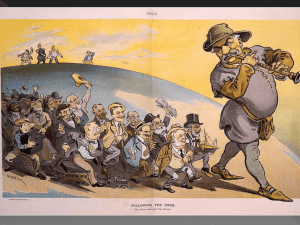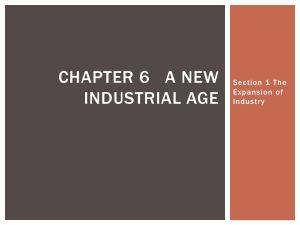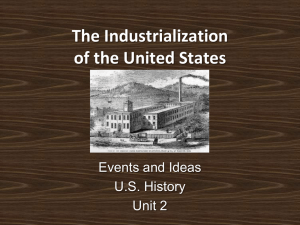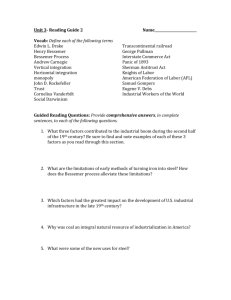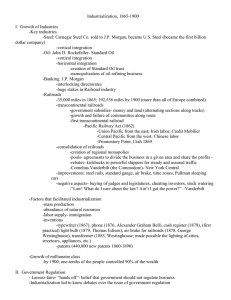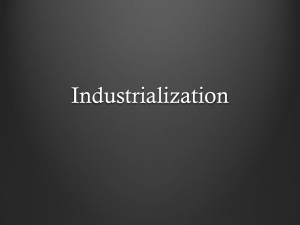Continued
advertisement
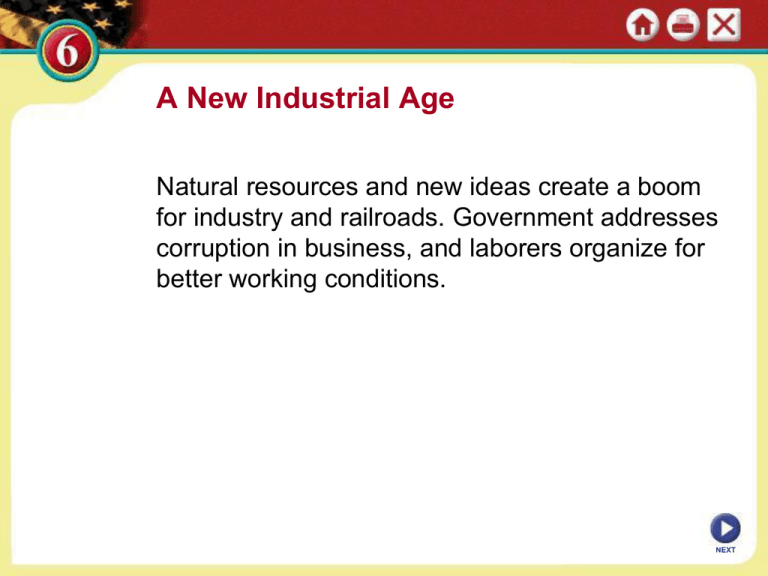
A New Industrial Age Natural resources and new ideas create a boom for industry and railroads. Government addresses corruption in business, and laborers organize for better working conditions. NEXT A New Industrial Age SECTION 1 The Expansion of Industry SECTION 2 The Age of the Railroads SECTION 3 Big Business and Labor NEXT Section 1 The Expansion of Industry At the end of the 19th century, natural resources, creative ideas, and growing markets fuel an industrial boom. NEXT SECTION 1 The Expansion of Industry Natural Resources Fuel Industrialization The Growth of Industry • By 1920s, U.S. is world’s leading industrial power, due to: - wealth of natural resources - government support for business - growing urban population Black Gold Pre-European arrival, Native Americans make fuel, medicine from oil ● 1859, Edwin L. Drake successfully uses steam engine to drill for oil ● Petroleum-refining industry first makes kerosene, then gasoline ● Continued . . . NEXT SECTION 1 continued Natural Resources Fuel Industrialization Bessemer Steel Process Abundant deposits of coal, iron spur industry ● Bessemer process puts air into iron to remove carbon to make steel ● Later open-hearth process makes steel from scrap or raw materials ● New Uses for Steel Steel used in railroads, barbed wire, farm machines ● Changes construction: Brooklyn Bridge; steel-framed skyscrapers ● NEXT SECTION 1 Inventions Promote Change An Age of Inventions Numerous new inventions change the landscape, life, work ● The Power of Electricity 1876, Thomas Alva Edison establishes first research laboratory - 1880, patents incandescent light bulb - creates system for electrical production, distribution ● Electricity changes business; by 1890, runs numerous machines ● Becomes available in homes; encourages invention of appliances ● Allows manufacturers to locate plants Continued . . . anyplace; industry grows ● NEXT SECTION 1 continued Inventions Promote Change Inventions Change Lifestyles • Christopher Sholes invents typewriter in 1867 • 1876, Alexander Graham Bell, Thomas Watson introduce telephone • Office work changes; by 1910, women are 40% of clerical workers • Inventions impact factory work, lead to industrialization - clothing factories hire many women • Industrialization makes jobs easier; improves standard of living - by 1890, average workweek 10 hours shorter - as consumers, workers regain power in market NEXT Section 2 The Age of the Railroads The growth and consolidation of railroads benefits the nation but also leads to corruption and required government regulation. NEXT SECTION 2 The Age of the Railroads Railroads Span Time and Space Railroads Encourage Growth • Rails make local transit reliable, westward expansion possible • Government makes land grants, loans to railroads - to help settle West - to develop country A National Network 1859, railroads extend west of Missouri River ● 1869, first transcontinental railroad completed, spans the nation ● Continued . . . NEXT SECTION 2 continued Railroads Span Time and Space Romance and Reality Railroads offer land, adventure, fresh start to many ● People of diverse backgrounds build railroad under harsh conditions: - Central Pacific hires Chinese immigrants - Union Pacific, Irish immigrants, Civil War vets ● Accidents, disease disable and kill thousands every year ● Railroad Time 1869, C. F. Dowd proposes dividing earth’s surface into 24 time zones ● 1883, U.S. railroads, towns adopt time zones ● 1884, international conference sets world zones, uses railroad time - Congress adopts in 1918 ● NEXT SECTION 2 Opportunities and Opportunists New Towns and Markets Railroads require great supply of materials, parts ● Iron, coal, steel, lumber, glass industries grow to meet demand ● Railroads link isolated towns, promote trade, interdependence ● Nationwide network of suppliers, markets develops ● Towns specialize, sell large quantities of their product nationally ● New towns grow along railroad lines ● Continued . . . NEXT SECTION 2 continued Opportunities and Opportunists Pullman 1880, George M. Pullman builds railcar factory on Illinois prairie ● Pullman provides for workers: housing, doctors, shops, sports field ● Company tightly controls residents to ensure stable work force ● Crédit Mobilier Wish for control, profit leads some railroad magnates to corruption ● Union Pacific stockholders form construction company, Crédit Mobilier - overpay for laying track, pocket profits ● Republican politicians implicated; reputation of party tarnished ● NEXT SECTION 2 The Grange and the Railroads Railroad Abuses Farmers angry over perceived railroad corruption - railroads sell government lands to businesses, not settlers - fix prices, keep farmers in debt - charge different customers different rates ● Granger Laws • Grangers sponsor state, local political candidates • Press for laws to protect farmers’ interests • Munn v. Illinois—Supreme Court upholds states’ right to regulate RR • Sets principle that federal government can regulate private industry Continued . . . NEXT SECTION 2 continued The Grange and the Railroads Interstate Commerce Act • 1886, Supreme Court: states cannot set rates on interstate commerce • Public outrage leads to Interstate Commerce Act of 1887 - federal government can supervise railroads - establishes Interstate Commerce Commission (ICC) • battle with railroads; difficult for ICC to take Panic Legal and Consolidation action ● Abuses, mismanagement, competition almost bankrupt many railroads ● Railroad problems contribute to panic of 1893, depression ● By mid-1894, 25% of railroads taken over by financial companies NEXT Section 3 Big Business and Labor The expansion of industry results in the growth of big business and prompts laborers to form unions to better their lives. NEXT New Business Culture 1. Laissez Faire the ideology of the Industrial Age. Individuals should compete freely in the marketplace. No room for government in the market! SECTION 3 Big Business and Labor Carnegie’s Innovations Carnegie Makes a Fortune • Andrew Carnegie one of first moguls to make own fortune New Business Strategies Carnegie searches for ways to make better products more cheaply ● Hires talented staff; offers company stock; promotes competition ● Uses vertical integration—buys out suppliers to control materials ● Through horizontal integration merges with competing companies ● Carnegie controls almost entire steel industry ● NEXT ANDREW CARNEGIE New Type of Business Entities 1. Pool 1887 Interstate Commerce Act Interstate Commerce Commission created. 2. Trust John D. Rockefeller Standard Oil Co. New Type of Business Entities 2. Trust: Horizontal Integration John D. Rockefeller Vertical Integration: o o Gustavus Swift Meat-packing Andrew Carnegie U. S. Steel William Vanderbilt $ The public be damned! $ What do I care about the law? H’aint I got the power? Cornelius [“Commodore”] Vanderbilt Can’t I do what I want with my money? New Financial Businessman The Broker: J. Pierpont Morgan The ‘Bosses’ of the Senate SECTION 3 Social Darwinism and Business Principles of Social Darwinism • Darwin’s theory of biological evolution: the best-adapted survive • Social Darwinism, or social evolution, based on Darwin’s theory • Economists use Social Darwinism to justify doctrine of laissez faire A New Definition of Success Idea of survival, success of the most capable appeals to wealthy ● Notion of individual responsibility in line with Protestant ethic ● See riches as sign of God’s favor; poor must be lazy, inferior ● NEXT . Social Darwinism × British economist. × Advocate of laissez-faire. × Adapted Darwin’s ideas from the “Origin of Species” to humans. × Notion of “Survival of the Fittest.” Herbert Spencer “On Wealth” $ The Anglo-Saxon race is superior. $ “Gospel of Wealth” (1901). $ Inequality is inevitable and good. $ Wealthy should act as “trustees” for their “poorer brethren.” Andrew Carnegie The Gospel of Wealth: Religion in the Era of Industrialization $ Wealth no longer looked upon as bad. $ Viewed as a sign of God’s approval. $ Christian duty to accumulate wealth. $ Should not help the poor. SECTION 3 Fewer Control More Growth and Consolidation • Businesses try to control industry with mergers— buy out competitors • Buy all others to form monopolies—control production, wages, prices • Holding companies buy all the stock of other companies • John D. Rockefeller founds Standard Oil Company, forms trust - trustees run separate companies as if one Continued . . . NEXT SECTION 3 continued Fewer Control More Rockefeller and the “Robber Barons” • Rockefeller profits by paying low wages, underselling others - when controls market, raises prices • Critics call industrialists robber barons - industrialists also become philanthropists Sherman Antitrust Act • Government thinks expanding corporations stifle free competition • Sherman Antitrust Act: trust illegal if interferes with free trade • Prosecuting companies difficult; government stops enforcing act Continued . . . NEXT SECTION 3 continued Fewer Control More Business Boom Bypasses the South South recovering from Civil War, hindered by lack of capital ● North owns 90% of stock in RR, most profitable Southern businesses ● Business problems: high transport cost, tariffs, few skilled workers ● NEXT SECTION 3 Labor Unions Emerge Long Hours and Danger Northern wages generally higher than Southern ● Exploitation, unsafe conditions unite workers across regions ● Most workers have 12 hour days, 6 day workweeks - perform repetitive, mind-dulling tasks - no vacation, sick leave, injury compensation ● To survive, families need all member to work, including children ● Sweatshops, tenement workshops often only jobs for women, children - require few skills; pay lowest wages ● Continued . . . NEXT Child Labor Child Labor SECTION 3 continued Labor Unions Emerge Early Labor Organizing National Labor Union—first large-scale national organization ● 1868, NLU gets Congress to give 8-hour day to civil servants ● Local chapters reject blacks; Colored National Labor Union forms ● NLU focus on linking existing local unions ● Noble Order of the Knights of Labor open to women, blacks, unskilled ● Knights support 8-hour day, equal pay, arbitration ● NEXT Knights of Labor Terence V. Powderly An injury to one is the concern of all! ù Goals of the Knights of Eight-hour workday. Labor ù Workers’ cooperatives. ù Worker-owned factories. ù Abolition of child and prison labor. ù Increased circulation of greenbacks. ù Equal pay for men and women. ù Safety codes in the workplace. ù Prohibition of contract foreign labor. ù Abolition of the National Bank. SECTION 3 Union Movements Diverge Craft Unionism • Craft unions include skilled workers from one or more trades • Samuel Gompers helps found American Federation of Labor (AFL) • AFL uses collective bargaining for better wages, hours, conditions • AFL strikes successfully, wins higher pay, shorter workweek Industrial Unionism • Industrial unions include skilled, unskilled workers in an industry • Eugene V. Debs forms American Railway Union; uses strikes Continued . . . NEXT The American Federation of Labor: 1886 Samuel Gompers SECTION 3 continued Union Movements Diverge Socialism and the IWW • Some labor activists turn to socialism: - government control of business, property - equal distribution of wealth • Industrial Workers of the World (IWW), or Wobblies, forms 1905 • Organized by radical unionists, socialists; include African Americans • Industrial unions give unskilled workers dignity, solidarity Other Labor Activism in the West Japanese, Mexicans form Sugar Beet and Farm Laborers’ Union in CA ● Wyoming Federation of Labor supports Chinese, Japanese miners ● NEXT The Socialists Eugene V. Debs “Big Bill” Haywood of the IWW Violence was justified to overthrow capitalism. International Workers of the World (“Wobblies”) SECTION 3 Strikes Turn Violent The Great Strike of 1877 Baltimore & Ohio Railroad strike spreads to other lines ● Governors say impeding interstate commerce; federal troops intervene ● The Haymarket Affair 3,000 gather at Chicago’s Haymarket Square, protest police brutality ● Violence ensues; 8 charged with inciting riot, convicted ● Public opinion turns against labor movement ● Continued . . . NEXT The Great Railroad Strike of 1877 Anarchists Meet on the Lake Front in 1886 Haymarket Riot (1886) McCormick Harvesting Machine Co. SECTION 3 continued Strikes Turn Violent The Homestead Strike 1892, Carnegie Steel workers strike over pay cuts ● Win battle against Pinkertons; National Guard reopens plant ● Steelworkers do not remobilize for 45 years ● The Pullman Company Strike Pullman lays off 3,000, cuts wages but not rents; workers strike ● Pullman refuses arbitration; violence ensues; federal troops sent ● Debs jailed, most workers fired, many blacklisted ● Continued . . . NEXT Homestead Steel Strike (1892) Homestead Steel Works The Amalgamated Association of Iron & Steel Workers A “Company Town”: Pullman, IL Pullman Cars A Pullman porter President Grover Cleveland If it takes the entire army and navy to deliver a postal card in Chicago, that card will be delivered! A Striker Confronts a SCAB! Management vs. Labor “Tools” of Management “Tools” of Labor “scabs” boycotts P. R. campaign sympathy demonstrations Pinkertons lockout blacklisting yellow-dog contracts informational picketing closed shops court injunctions organized strikes open shop “wildcat” strikes SECTION 3 continued Strikes Turn Violent Women Organize • Women barred from many unions; unite behind powerful leaders • Mary Harris Jones— most prominent organizer in women’s labor - works for United Mine Workers - leads children’s march • Pauline Newman—organizer for International Ladies’ Garment Workers • 1911 Triangle Shirtwaist factory fire results in public outrage Management and Government Pressure Unions • Employers forbid unions; turn Sherman Antitrust Act against labor • Legal limitations cripple unions, but membership NEXT Mother Jones: “The Miner’s Angel” Mary Harris. Organizer for the United Mine Workers. Founded the Social Democratic Party in 1898. One of the founding members of the I. W. W. in 1905. Print Slide Show 1. On the File menu, select Print 2. In the pop-up menu, select Microsoft PowerPointIf the dialog box does not include this pop-up, continue to step 4 3. In the Print what box, choose the presentation format you want to print: slides, notes, handouts, or outline 4. Click the Print button to print the PowerPoint presentation BACK
